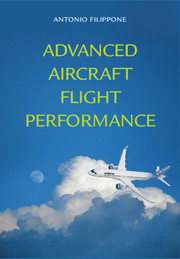Book contents
- Frontmatter
- Contents
- Tables
- Preface
- Nomenclature
- Technology Warning
- 1 Prolegomena
- 2 Aircraft Models
- 3 Weight and Balance Performance
- 4 Aerodynamic Performance
- 5 Engine Performance
- 6 Propeller Performance
- 7 Airplane Trim
- 8 Flight Envelopes
- 9 Take-Off and Field Performance
- 10 Climb Performance
- 11 Descent and Landing Performance
- 12 Cruise Performance
- 13 Manoeuvre Performance
- 14 Thermo-Structural Performance
- 15 Mission Analysis
- 16 Aircraft Noise: Noise Sources
- 17 Aircraft Noise: Propagation
- 18 Aircraft Noise: Flight Trajectories
- 19 Environmental Performance
- 20 Epilogue
- Appendix A Gulfstream G-550
- Appendix B Certified Aircraft Noise Data
- Appendix C Options for the FLIGHT Program
- Index
- References
1 - Prolegomena
Published online by Cambridge University Press: 05 January 2013
- Frontmatter
- Contents
- Tables
- Preface
- Nomenclature
- Technology Warning
- 1 Prolegomena
- 2 Aircraft Models
- 3 Weight and Balance Performance
- 4 Aerodynamic Performance
- 5 Engine Performance
- 6 Propeller Performance
- 7 Airplane Trim
- 8 Flight Envelopes
- 9 Take-Off and Field Performance
- 10 Climb Performance
- 11 Descent and Landing Performance
- 12 Cruise Performance
- 13 Manoeuvre Performance
- 14 Thermo-Structural Performance
- 15 Mission Analysis
- 16 Aircraft Noise: Noise Sources
- 17 Aircraft Noise: Propagation
- 18 Aircraft Noise: Flight Trajectories
- 19 Environmental Performance
- 20 Epilogue
- Appendix A Gulfstream G-550
- Appendix B Certified Aircraft Noise Data
- Appendix C Options for the FLIGHT Program
- Index
- References
Summary
Commercial aviation has grown to become the backbone of the modern transport system. Demand for commercial air travel has grown exponentially since the 1960s. The expansion of the aviation services is set to increase further. Even in the worst moments of recession, air transport has only suffered a blip in its expansion. Our global economy has become so dependent on air transport that any inconvenience caused by weather and external factors can cause mayhem. To understand the size of commercial aviation, reflect upon the fact that by the year 2000, there had been 35.14 million commercial departures worldwide, for a total of 18.14 million flight hours. In some countries, air transport accounts for one quarter of all transported goods by value. It is estimated that there are about 50,000 airports and airfields around the world and 18,000 commercial airplanes flying every day. A number of large airports are being constructed in some rapidly expanding regions. Modern airports are the size of a city: London Heathrow covers about 12 km2; this is an area large enough to park about 1,800 Airbus A380s nose-to-tail. The support required by the aircraft is extraordinary and involves engineering, logistics, integrated transport systems, security systems, energy and people. However, at the heart of everything is the aircraft itself, interpreted as a flight system: this is the subject of our book. There will be only a superficial mention of various externalities, including air traffic control, queueing models, stack patterns, logistics, supply chains, and so on.
- Type
- Chapter
- Information
- Advanced Aircraft Flight Performance , pp. 1 - 15Publisher: Cambridge University PressPrint publication year: 2012



